KitchenAid KSSC36FKB00, KSSC36FKS00, KSSC36QKS00, KSSC42FKB00, KSSC42FKS00 Service Manual
...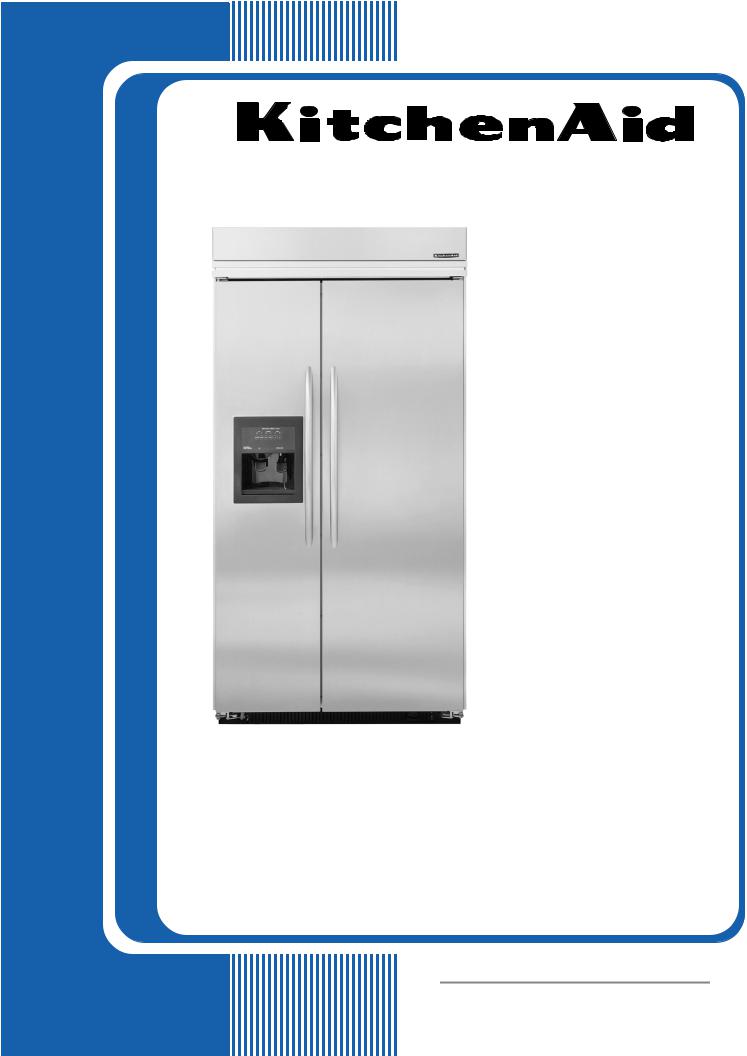
KAR-11
TECHNICAL EDUCATION
MODELS:
KSSC36FKB00 KSSS42FKB00
KSSC36FKS00 KSSS42FKT00
KSSC36QKS00 KSSS42FKW00
KSSC42FKB00 KSSS42FKX00
KSSC42FKS00 KSSS42QKB00
KSSC42QKS00 KSSS42QKT00
KSSC48FKB00 KSSS42QKW00
KSSC48FKS00 KSSS42QKX00
KSSC48QKS00 KSSS48FKB00
KSSP36QKS00 KSSS48FKT00
KSSP42QKS00 KSSS48FKW00
KSSP48QKS00 KSSS48FKX00
KSSS36FKB00 KSSS48QKB00
KSSS36FKT00 KSSS48QKT00
KSSS36FKW00 KSSS48QKW00
KSSS36FKX00 KSSS48QKX00
KSSS36QKB00
KSSS36QKT00
KSSS36QKW00
KSSS36QKX00
2001 K MODEL
BUILT-IN SIDE-BY-SIDE
REFRIGERATOR WITH VARIABLE CAPACITY COMPRESSOR
JOB AID 4317326A
www.Appliantology.org

FORWARD
This KitchenAid Job Aid, 2001 K Model Built-In Side-By-Side Refrigerator With Variable Capacity Compressor (Part No. 4317326A), provides the technician with information on the installation and service of the Built-In Side-By-Side Refrigerator. It is to be used as a training Job Aid and Service Manual. For specific information on the model being serviced, refer to the “Use and Care Guide,” or “Tech Sheet” provided with the refrigerator.
The Wiring Diagrams and Strip Circuits used in this Job Aid are typical and should be used for training purposes only. Always use the Wiring Diagram supplied with the product when servicing the unit.
GOALS AND OBJECTIVES
The goal of this Job Aid is to provide detailed information that will enable the service technician to properly diagnose malfunctions and repair the Built-In Side-By-Side Refrigerator.
The objectives of this Job Aid are to:
•Understand and follow proper safety precautions.
•Successfully troubleshoot and diagnose malfunctions.
•Successfully perform necessary repairs.
•Successfully return the refrigerator to its proper operational status.
WHIRLPOOL CORPORATION assumes no responsibility for any repairs made on our products by anyone other than Authorized Service Technicians.
Copyright © 2002, Whirlpool Corporation, Benton Harbor, MI 49022
www.Appliantology- ii - .org

TABLE OF CONTENTS
|
Page |
GENERAL |
1-1 |
Safety First................................................................................................................... |
...... 1-1 |
Electrical Power Supply & Grounding Requirements ................................................... |
1-1 |
Anti-Tip Requirements.................................................................................................. |
1-2 |
Electrostatic Discharge (ESD) Sensitive Electronics.................................................... |
1-2 |
Model & Serial Number Designations ................................................................................ |
1-3 |
Model & Serial Number Label And Tech Sheet Locations................................................. |
1-4 |
Specifications................................................................................................................. .... |
1-5 |
Refrigerator Warranty ........................................................................................................ |
1-8 |
INSTALLATION INFORMATION ........................................................................................... |
2-1 |
THEORY OF OPERATION ..................................................................................................... |
3-1 |
COMPONENT ACCESS ......................................................................................................... |
4-1 |
Component Locations ........................................................................................................ |
4-1 |
Removing The Unit Compartment Cover........................................................................... |
4-2 |
Removing A Door Switch, The Power Switch, The Inverter Assembly, |
|
And The Main Control Board Assembly.......................................................................... |
4-4 |
Removing The Condenser Fan Motor ............................................................................... |
4-8 |
Removing The Compressor And Filter/Drier...................................................................... |
4-9 |
Removing The Bimetal, The Evaporator Fan Motor, |
|
The Defrost Heater, And The Evaporator ..................................................................... |
4-10 |
Removing The Touch/Display Board & The Motorized Air Door ..................................... |
4-14 |
Removing The Ice Maker And The Auger Motor & Crush/Cube Solenoid....................... |
4-16 |
Removing A Thermistor ................................................................................................... |
4-18 |
Removing A Light Socket ................................................................................................ |
4-19 |
Removing The Water Reservoir ...................................................................................... |
4-20 |
Removing The Water Valve ............................................................................................. |
4-22 |
Removing The Water & Ice Dispenser ............................................................................ |
4-23 |
Removing A Door Gasket ................................................................................................ |
4-25 |
Removing The Freezer Or Refrigerator Door .................................................................. |
4-26 |
COMPONENT TESTING ........................................................................................................ |
5-1 |
Thermistor..................................................................................................................... ..... |
5-1 |
Evaporator Fan Motor ........................................................................................................ |
5-2 |
Condenser Fan Motor ........................................................................................................ |
5-2 |
Compressor & Inverter....................................................................................................... |
5-3 |
Motorized Air Door ............................................................................................................. |
5-4 |
Defrost Heater & Bimetal ................................................................................................... |
5-4 |
Main Control Board ............................................................................................................ |
5-5 |
Crush/Cube Solenoid......................................................................................................... |
5-6 |
Ice Maker Auger Motor ...................................................................................................... |
5-6 |
Water Valve Solenoid ........................................................................................................ |
5-7 |
Door Switch .................................................................................................................... ... |
5-7 |
www.Appliantology- iii - .org

|
Page |
DIAGNOSIS & TROUBLESHOOTING ................................................................................... |
6-1 |
Diagnosis ...................................................................................................................... ..... |
6-1 |
Pre-Diagnostics Checks ................................................................................................. |
6-1 |
Diagnostics Mode ........................................................................................................... |
6-1 |
Water Filter Input (WFI) Test .......................................................................................... |
6-2 |
Troubleshooting Chart ....................................................................................................... |
6-3 |
WIRING DIAGRAMS & STRIP CIRCUITS ............................................................................. |
7-1 |
Wiring Diagram—Bottom Mount ........................................................................................ |
7-1 |
Wiring Diagram—Side-By-Side Models ............................................................................. |
7-2 |
Strip Circuits ................................................................................................................. ..... |
7-3 |
www.Appliantology- iv - .org
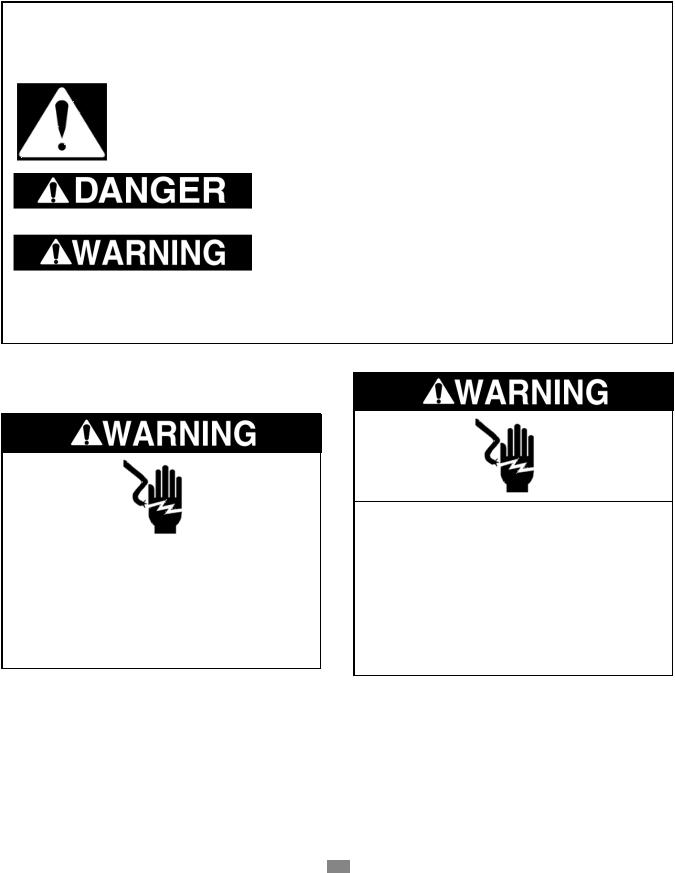
GENERAL
SAFETY FIRST
Your safety and the safety of others is very important.
We have provided many important safety messages in this Job Aid and on the appliance. Always read and obey all safety messages.
This is the safety alert symbol.
This symbol alerts you to hazards that can kill or hurt you and others.
All safety messages will follow the safety alert symbol and either the word “DANGER” or “WARNING.” These words mean:
You can be killed or seriously injured if you don’t immediately follow instructions.
You can be killed or seriously injured if you don’t follow instructions.
All safety messages will tell you what the potential hazard is, tell you how to reduce the chance of injury, and tell you what can happen if the instructions are not followed.
ELECTRICAL POWER SUPPLY &
GROUNDING REQUIREMENTS
Electrical Shock Hazard Disconnect power before servicing.
Replace all panels before operating.
Failure to do so can result in death or electrical shock.
Electrical Shock Hazard Plug into a grounded 3-prong outlet.
Do not remove ground prong.
Do not use an adapter.
Do not use an extension cord.
Failure to follow these instructions can result in death, fire, or electrical shock.
www.Appliantology1-1 .org
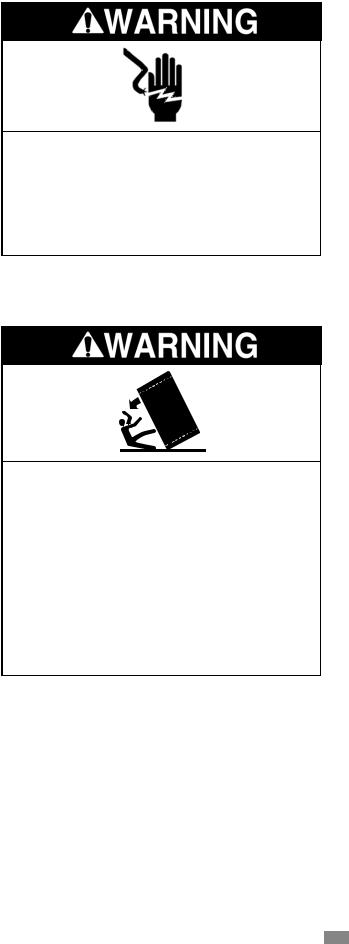
Electrical Shock Hazard Connect green ground wire to ground
screw.
Failure to do so can result in death or electrical shock.
ANTI-TIP
REQUIREMENTS
Tip Over Hazard
Refrigerator is top heavy and tips easily when not completely installed.
Keep doors taped closed until refrigerator is completely installed.
Use two or more people to move and install refrigerator.
Failure do so can result in death or serious injury.
ELECTROSTATIC DISCHARGE (ESD) SENSITIVE ELECTRONICS
ESD problems are present everywhere. ESD may damage or weaken the electronic control assembly. The new control assembly may appear to work well after repair is finished, but failure may occur at a later date due to ESD stress.
•Use an antistatic wrist strap. Connect the wrist strap to a green ground connection point or unpainted metal in the appliance; or touchyourfingerrepeatedlytoagreenground connection point or unpainted metal in the appliance.
•Before removing the part from its package, touch the antistatic bag to a green ground connection point or unpainted metal in the appliance.
•Avoid touching electronic parts or terminal contacts. Handle the electronic control assembly by the edges only.
•When repackaging the failed electronic control assembly in an antistatic bag, observe the above instructions.
www.Appliantology1-2 .org
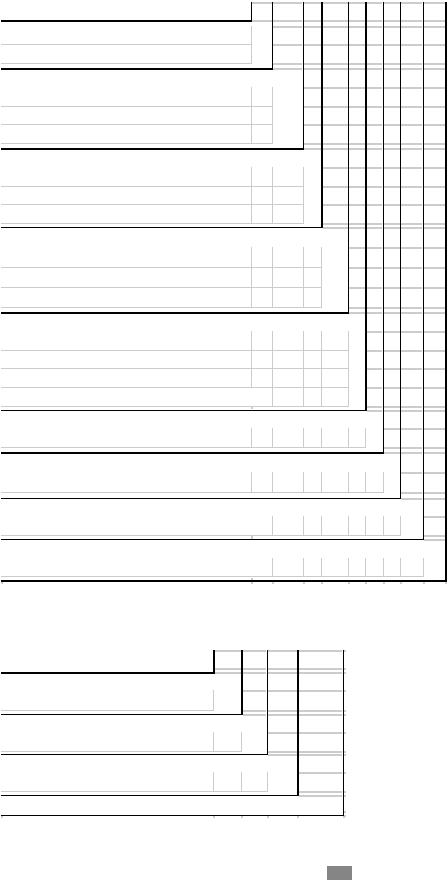
MODEL & SERIAL NUMBER DESIGNATIONS
MODEL NUMBER
MODEL NUMBER |
K S S S 4 2 Q K X 0 0 |
PRODUCT GROUP
K = KitchenAid Brand
PRODUCT IDENTIFICATION
BR = Bottom Mount Right Hand Hinge
BL = Bottom Mount Left Hand Hinge
SS = Side-By-Side Built-In
MERCHANDISING SCHEME/SERIES
C = Wrap Around Stainless Steel
P = Factory Installed Panel Kit
S = Framed Trim Kit (Panels Not Included)
CAPACITY/ SIZE
36 = 36″ Width
42 = 42″ Width
48 = 48″ Width
FEATURES
D = Ice & Water Dispensing
F = Factory Installed Ice Maker w/Filter
M = Factory Installed Ice Maker wo/Filter
Q = Ice/Crushed Ice & Water Dispensing w/Filter
YEAR OF INTRODUCTION
K = 2001
COLOR CODE
X = No Color Used
ENERGY POWER CONSUMPTION CHANGE
0 = Original, 1 = 1st Change, 2 = 2nd Change, Etc.
ENGINEERING CHANGE (NUMERIC)
0 = Original, 1 = 1st Change, 2 = 2nd Change, Etc.
SERIAL NUMBER
SERIAL NUMBER |
Q L 30 10003 |
MANUFACTURING SITE
Q = LaVergne, TN
YEAR OF PRODUCTION
L = 2001
WEEK OF PRODUCTION
30th WEEK
PRODUCT SEQUENCE NUMBER
www.Appliantology1-3 .org

MODEL & SERIAL NUMBER LABEL
AND TECH SHEET LOCATIONS
The Model/Serial Number Label and Tech Sheet locations are shown below.
Model & Serial Number Location 
(Freezer Compartment)
Tech Sheet Location
(On Unit Compartment Cover)
www.Appliantology1-4 .org
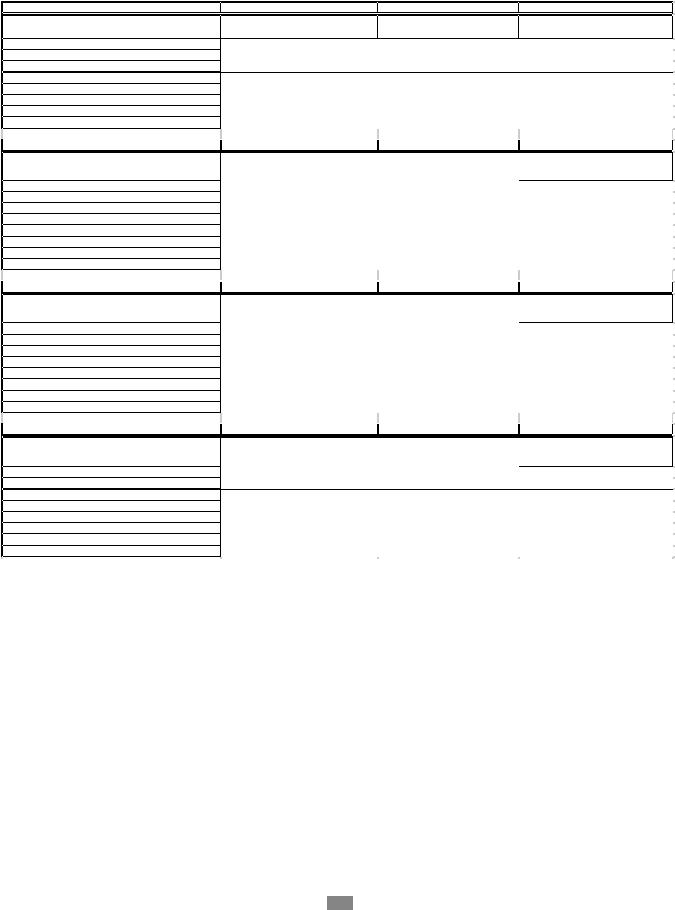
SPECIFICATIONS
Model Number |
KSSC36FKB |
KSSC36FKS |
K S S C 3 6 Q K S |
|
Model Description |
Black Architect Series - Non-Disp. |
Architect Series - Non-Dispenser with |
Stainless Steel Architect Series - |
|
with water filter |
water filter |
Disp. - with water filter |
||
|
||||
Size-Configuration |
36" |
36" |
36" |
|
Refrigerator Volume (Cu Ft) |
13 |
13 |
13 |
|
Freezer Volume (Cu Ft) |
7.5 |
7.5 |
7.4 |
|
Crated Weight (lbs) |
500 |
500 |
500 |
|
|
|
|
|
|
Refrigerant |
134a |
134a |
134a |
|
Standard Warranty (Months) |
24 |
24 |
24 |
|
Full Liner And Sealed System Warranty (Months) |
72 |
72 |
72 |
|
Sealed System Warranty (Months) |
144 |
144 |
144 |
Model Number |
KSSC42FKB |
KSSC42FKS |
K S S C 4 2 Q K S |
|
Model Description |
Black Architect Series - Non-Dispenser |
Architect Series - Non-Dispenser |
Stainless Steel Architect - |
|
with water filter |
with water filter |
Dispenser with water filter |
||
|
||||
Size-Configuration |
42" |
42" |
42" |
|
Refrigerator Volume (Cu Ft) |
13 |
15.6 |
15.7 |
|
Freezer Volume (Cu Ft) |
9.1 |
9.1 |
8.9 |
|
Crated Weight (lbs) |
552 |
552 |
552 |
|
|
|
|
|
|
Refrigerant |
134a |
134a |
134a |
|
Standard Warranty (Months) |
24 |
24 |
24 |
|
Full Liner And Sealed System Warranty (Months) |
72 |
72 |
72 |
|
Sealed System Warranty (Months) |
144 |
144 |
144 |
Model Number |
KSSC48FKB |
KSSC48FKS |
K S S C 4 8 Q K S |
|
Model Description |
Black Architect Series - Non-Dispenser |
Architect Series - Non-Dispenser with |
Stainless Steel Architect Series |
|
with water filter |
water filter |
with Dispenser with Water Filter |
||
|
||||
Size-Configuration |
48" |
48" |
48" |
|
Refrigerator Volume (Cu Ft) |
18.3 |
18.3 |
18.4 |
|
Freezer Volume (Cu Ft) |
10.7 |
10.7 |
10.5 |
|
Crated Weight (lbs) |
579 |
579 |
579 |
|
|
|
|
|
|
Refrigerant |
134a |
134a |
134a |
|
Standard Warranty (Months) |
24 |
24 |
24 |
|
Full Liner And Sealed System Warranty (Months) |
72 |
72 |
72 |
|
Sealed System Warranty (Months) |
144 |
144 |
144 |
Model Number |
KSSP36QKS |
KSSP42QKS |
KSSP48QKS |
|
Model Description |
Stainless Steel - Dispenser - Factory |
Stainless Steel - Dispenser - Factory |
Stainless Steel - Dispenser - Factory |
|
Installed Panels with water filter |
Installed Panels with water filter |
Installed Panels with Water Filter |
||
|
||||
Size-Configuration |
36" |
42" |
48" |
|
Refrigerator Volume (Cu Ft) |
13 |
15.7 |
18.4 |
|
Freezer Volume (Cu Ft) |
7.4 |
8.9 |
10.5 |
|
Crated Weight (lbs) |
500 |
552 |
579 |
|
Refrigerant |
134a |
134a |
134a |
|
Standard Warranty (Months) |
24 |
24 |
24 |
|
Full Liner And Sealed System Warranty (Months) |
72 |
72 |
72 |
|
Sealed System Warranty (Months) |
144 |
144 |
144 |
www.Appliantology1-5 .org
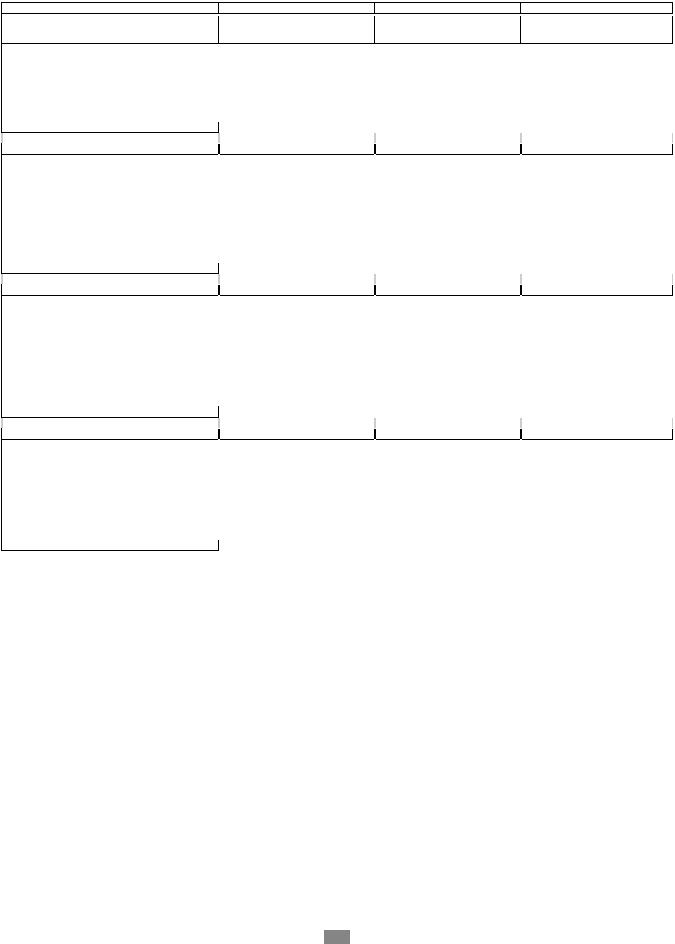
Model Number |
KSSS36FKB |
KSSS36FKT |
KSSS36FKW |
|
Model Description |
Black Trim -Custom Panels Required- |
Biscuit Trim -Custom Panels Required- |
White Trim-Non-Dispenser-Custom |
|
Non-Dispenser with water filter |
Non-Dispenser with water filter |
Panels Required with water filter |
||
|
||||
Size-Configuration |
36" |
36" |
36" |
|
Refrigerator Volume (Cu Ft) |
13 |
13 |
13 |
|
Freezer Volume (Cu Ft) |
7.5 |
7.5 |
7.5 |
|
Crated Weight (lbs) |
500 |
500 |
500 |
|
|
|
|
|
|
Refrigerant |
134a |
134a |
134a |
|
Standard Warranty (Months) |
24 |
24 |
24 |
|
Full Liner And Sealed System Warranty (Months) |
72 |
72 |
72 |
|
Sealed System Warranty (Months) |
144 |
144 |
144 |
Model Number |
KSSS36FKX |
KSSS36QKB |
K S S S 3 6 Q K T |
|
Model Description |
Brushed Aluminum Trim -Custom Panels |
KitchenAid Black |
KitchenAid Biscuit |
|
Required-Non-Dispenser with water filter |
Dispenser Water Filter |
Dispenser Water Filter |
||
|
||||
Size-Configuration |
36" |
36" Side By Side |
36" Side by Side |
|
Refrigerator Volume (Cu Ft) |
13 |
13 |
13 |
|
Freezer Volume (Cu Ft) |
7.5 |
7.4 |
7.4 |
|
Crated Weight (lbs) |
500 |
500 |
500 |
|
|
|
|
|
|
Refrigerant |
134a |
134a |
134a |
|
Standard Warranty (Months) |
24 |
24 |
24 |
|
Full Liner And Sealed System Warranty (Months) |
72 |
60 |
60 |
|
Sealed System Warranty (Months) |
144 |
144 |
144 |
Model Number |
K S S S 3 6 Q K W |
KSSS36QKX |
KSSS42FKB |
|
Model Description |
KitchenAid White Dispenser |
KitchenAid Black Dispenser |
Black Trim - Non-Dispenser with water |
|
with Water Filter |
with Water Filter |
filterCustom Panels Required |
||
|
||||
Size-Configuration |
36" Side By Side |
36" Side By Side |
42" |
|
Refrigerator Volume (Cu Ft) |
13 |
13 |
15.6 |
|
Freezer Volume (Cu Ft) |
7.4 |
7.4 |
9.1 |
|
Crated Weight (lbs) |
500 |
500 |
552 |
|
Refrigerant |
134a |
134a |
134a |
|
Standard Warranty (Months) |
24 |
24 |
24 |
|
Full Liner And Sealed System Warranty (Months) |
60 |
60 |
72 |
|
Sealed System Warranty (Months) |
144 |
144 |
144 |
Model Number |
KSSS42FKT |
KSSS42FKW |
KSSS42FKX |
|
Model Description |
Biscuit Trim - Non-Dispenser with water |
White Trim - Non-Dispenser with water |
Brushed Aluminum Trim - Non-Dispenser |
|
filterCustom Panels Required |
filterCustom Panels Required |
with water filterCustom Panels Required |
||
|
||||
Size-Configuration |
42" |
42" |
42" |
|
Refrigerator Volume (Cu Ft) |
15.6 |
15.6 |
15.6 |
|
Freezer Volume (Cu Ft) |
9.1 |
9.1 |
9.1 |
|
Crated Weight (lbs) |
552 |
552 |
552 |
|
|
|
|
|
|
Refrigerant |
134a |
134a |
134a |
|
Standard Warranty (Months) |
24 |
24 |
24 |
|
Full Liner And Sealed System Warranty (Months) |
72 |
72 |
72 |
|
Sealed System Warranty (Months) |
144 |
144 |
144 |
www.Appliantology1-6 .org
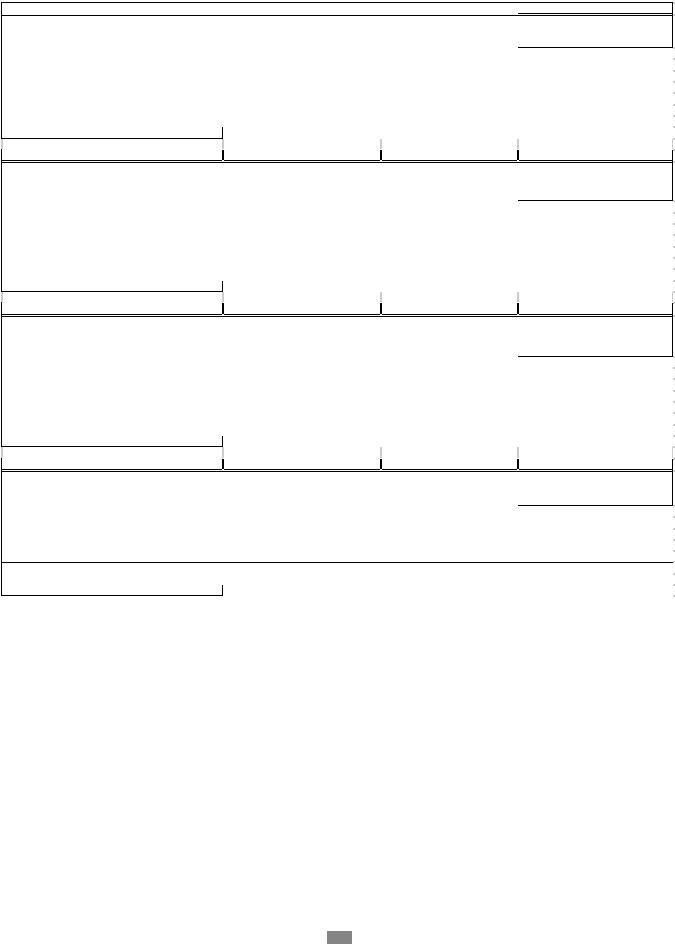
Model Number |
KSSS42QKB |
K S S S 4 2 Q K T |
K S S S 4 2 Q K W |
|
Model Description |
KitchenAid Black Dispenser |
KitchenAid Biscuit |
KitchenAid White Water Filter |
|
Water with Filter |
with Water Filter |
|||
|
|
|||
Size-Configuration |
42" Side by Side |
42" Side by Side |
42" Side by Side |
|
Refrigerator Volume (Cu Ft) |
15.7 |
15.7 |
15.7 |
|
Freezer Volume (Cu Ft) |
8.9 |
8.9 |
8.9 |
|
Crated Weight (lbs) |
552 |
552 |
552 |
|
|
|
|
|
|
Refrigerant |
134a |
134a |
134a |
|
Standard Warranty (Months) |
24 |
24 |
24 |
|
Full Liner And Sealed System Warranty (Months) |
72 |
72 |
72 |
|
Sealed System Warranty (Months) |
144 |
144 |
144 |
Model Number |
KSSS42QKX |
KSSS48FKB |
KSSS48FKT |
|
Model Description |
Black Dispenser-Brushed Aluminum |
Black Trim Model-Custom |
Biscuit Trim Model-Custom Panels |
|
Panels Required-Non-Dispenser |
||||
Trim-Custom Panels Required |
Required-Non-Dispenser with water filter |
|||
|
with water filter |
|||
|
|
|
||
Size-Configuration |
42" |
48" |
48" |
|
Refrigerator Volume (Cu Ft) |
15.7 |
18.3 |
18.3 |
|
Freezer Volume (Cu Ft) |
8.9 |
10.7 |
10.7 |
|
|
|
|
|
|
Crated Weight (lbs) |
552 |
579 |
579 |
|
|
|
|
|
|
Refrigerant |
134a |
134a |
134a |
|
Standard Warranty (Months) |
24 |
24 |
24 |
|
Full Liner And Sealed System Warranty (Months) |
72 |
72 |
72 |
|
Sealed System Warranty (Months) |
144 |
144 |
144 |
Model Number |
KSSS48FKW |
KSSS48FKX |
KSSS48QKB |
|
Model Description |
White Trim Model-Custom Panels Required- |
Brushed Aluminum Trim Model- |
KitchenAid Black Dispenser |
|
Custom Panels Required-Non- |
||||
Non-Dispenser with water filter |
Water with Filter |
|||
|
Dispenser with water filter |
|||
|
|
|
||
Size-Configuration |
48" |
48" |
48" Side by Side |
|
Refrigerator Volume (Cu Ft) |
18.3 |
18.3 |
18.4 |
|
Freezer Volume (Cu Ft) |
10.7 |
10.7 |
10.5 |
|
Crated Weight (lbs) |
579 |
579 |
579 |
|
|
|
|
|
|
Refrigerant |
134a |
134a |
134a |
|
Standard Warranty (Months) |
24 |
24 |
24 |
|
Full Liner And Sealed System Warranty (Months) |
72 |
72 |
72 |
|
Sealed System Warranty (Months) |
144 |
144 |
144 |
Model Number |
K S S S 4 8 Q K T |
K S S S 4 8 Q K W |
KSSS48QKX |
|
Model Description |
KitchenAid Biscuit Dispenser |
KitchenAid White Dispenser |
KitchenAid Water Filter Black Dispenser- |
|
with Water Filter |
Water with Filter |
Brushed Aluminum Trim- |
||
|
||||
Size-Configuration |
48" Side by Side |
48" Side by Side |
48" Side by Side |
|
Refrigerator Volume (Cu Ft) |
18.4 |
18.4 |
18.4 |
|
Freezer Volume (Cu Ft) |
10.5 |
10.5 |
10.5 |
|
Crated Weight (lbs) |
579 |
579 |
579 |
|
Refrigerant |
134a |
134a |
134a |
|
Standard Warranty (Months) |
24 |
24 |
24 |
|
Full Liner And Sealed System Warranty (Months) |
72 |
72 |
72 |
|
Sealed System Warranty (Months) |
144 |
144 |
144 |
www.Appliantology1-7 .org

KITCHENAID® BUILT-IN REFRIGERATOR WARRANTY
TWO-YEAR FULL WARRANTY ON REFRIGERATOR
For two years from the date of installation, when this refrigerator (excluding the water filter cartridges) is operated and maintained according to instructions attached to or furnished with the product, KitchenAid will pay for factory specified replacement parts and repair labor costs to correct defects in materials or workmanship. Replacement parts and labor costs to correct defects in light bulbs, one year. Service must be provided by a KitchenAid designated service company.
Water filter cartridge: 30 day limited warranty on water filter. For 30 days from the date of purchase, when this filter is operated and maintained according to instructions attached to or furnished with the product, KitchenAid will pay for replacement parts to correct defects in materials and workmanship.
THIRD THROUGH SIXTH YEAR LIMITED WARRANTY
In third through sixth years from the date of installation, when this refrigerator is operated and maintained according to instructions attached to or furnished with the product, KitchenAid will pay for factory specified replacement parts and repair labor costs to correct defects in materials or workmanship in the sealed refrigeration system. These parts are: compressor, evaporator, condenser, dryer, and connecting tubing. Service must be performed by a KitchenAid designated service company.
SEVENTH THROUGH TWELFTH YEAR LIMITED WARRANTY
In seventh through twelfth years from date of installation, when this refrigerator is operated and maintained according to instructions attached to or furnished with the product, KitchenAid will pay for factory specified replacement parts to correct defects in materials or workmanship in the sealed refrigeration system. These parts are: compressor, evaporator, condenser, dryer, and connecting tubing.
LIMITED LIFETIME WARRANTY
For the life of the product, when this refrigerator is operated and maintained according to instructions attached to or furnished with the product, KitchenAid will replace all Door Bins due to defective materials or workmanship.
KitchenAid will not pay for:
1.Service calls to correct the installation of the refrigerator, to instruct you how to use the refrigerator, to replace house fuses or correct house wiring or plumbing, to replace light bulbs, or to replace water filters other than as noted above.
2.Repairs when the refrigerator is used in other than normal, single-family household use.
3.Pickup and delivery. The refrigerator is designed to be repaired in the home.
4.Damage resulting from accident, alteration, misuse, abuse, fire, flood, improper installation, acts of God, or use of products not approved by KitchenAid or KitchenAid Canada.
5.Any food or medicine loss due to product failure.
6.Repairs to parts or systems resulting from unauthorized modifications made to the appliance.
7.Removal and replacement of trim or decorative panels that interfere with servicing the product.
8.Labor or parts installed by any non-designated service company during the full warranty period, unless approved by KitchenAid before service is performed.
9.In Canada, travel or transportation expenses for customers who reside in remote areas.
10.Any labor costs during the limited warranty periods, except as stated above.
KITCHENAID AND KITCHENAID CANADA SHALL NOT BE LIABLE FOR INCIDENTAL OR CONSEQUENTIAL DAMAGES.
Some states or provinces do not allow the exclusion or limitation of incidental or consequential damages, so this exclusion or limitation may not apply to you. This warranty gives you specific legal rights, and you may also have other rights which vary from state to state or province to province.
Outside the 50 United States and Canada, a different warranty may apply. Contact your authorized KitchenAid dealer to determine if another warranty applies.
If you need service, first see the “Troubleshooting” section of the Use & Care Guide. After checking “Troubleshooting,” additional help can be found by checking the “Assistance or Service” section or by calling the KitchenAid Customer Interaction Center, 1-800-422-1230 (toll-free), from anywhere in the U.S.A. In Canada,
contact your designated KitchenAppliantologyid Canada A liance service company or call: 1-800-807-6777
www. 1-8 .org
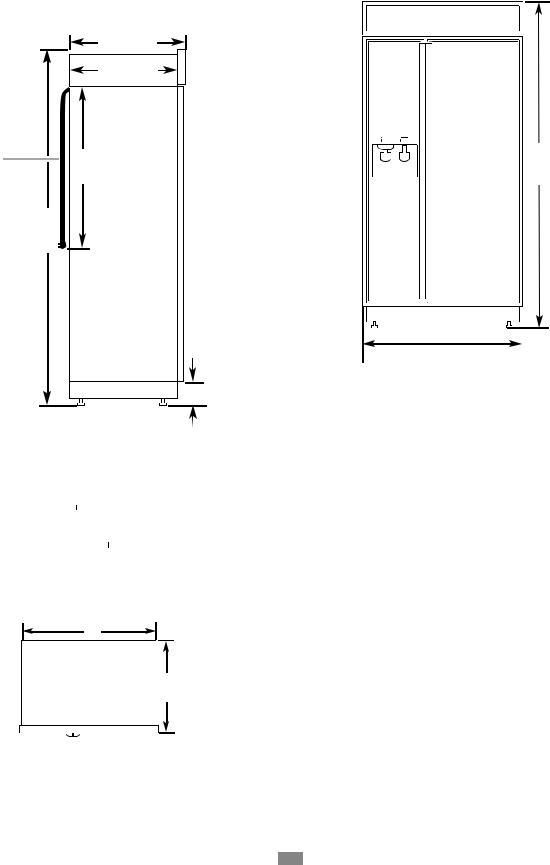
INSTALLATION INFORMATION
PRODUCT DIMENSIONS
Side View
1 251/8"
251/8"
(64 cm)
231/2"
(60 cm)
2 |
24" |
|
(61 cm) |
831/8"
(211 cm)*
3
31/2" (9 cm)*
1.25-1/8" (64 cm) dimension is to front of top grille
2.Power cord (24") (61 cm)
3.5 ft. (1.5 m) water line tubing taped to back
NOTE: (*) Dimensions shown are for leg levelers extended 1/8 (3 mm) below the rollers. For levelers fully extended 1-1/4 (32 mm) below the rollers, add 1-1/8 (29 mm) to this dimension.
Top View
A
25-1/8"
(64 cm)
|
|
|
|
|
|
|
|
Model |
Width A |
||
|
|
|
|
36" (91 cm) |
35" (89 cm) |
||
42" (106 cm) |
41" (104 cm) |
||
48" (122 cm) |
47" (119 cm) |
||
|
|
|
|
Front View
831/8"
(211 cm)
|
|
|
|
|
|
|
|
|
|
|
|
|
|
|
|
|
|
|
|
|
|
|
|
|
|
|
|
|
A |
|
|
|
|
|
|
|
(see chart following) |
|
|
|||||
|
|
|||||||
Width of Refrigerator |
||||||||
|
|
|
|
|
|
|
|
|
Model |
|
|
|
Width A (as shown above) |
||||
|
|
|
|
|
|
|
|
|
36" (91 cm) |
|
|
|
36-1/4" (92 cm) |
||||
42" (106 cm) |
|
|
|
42-1/4" (107 cm) |
||||
48" (122 cm) |
|
|
|
48-1/4" (123 cm) |
||||
|
|
|
|
|
|
|
|
|
NOTE: The width dimensions shown represent the distance from outside trim to outside trim.
www.Appliantology2-1 .org
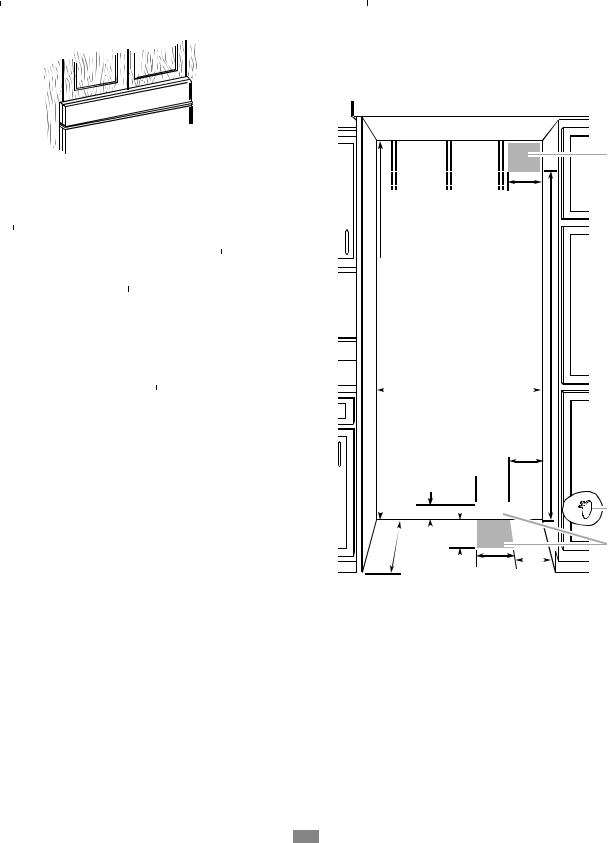
Openings
The built-in refrigerator can be installed into a recessed opening in the cabinets, or at the end of cabinets using a side panel to enclose the refrigerator side. The installation requires a 1/2 (12.7 mm) clearance to remove the top grille and for proper air flow.
1
1. A 1/2" (12.7 mm) space is required
Wall studs must be located on the rear wall 80 to 90 (203 - 229 cm) above the floor.
The solid soffit must be within 1 (2.5 cm) maximum above the refrigerator. If the solid soffit is higher than 1 (2.5 cm), or one is not available, then the refrigerator must be braced to prevent tipping during use. See “Anti-Tip Boards” on page 2-3.
A grounded electrical outlet should be placed in the top shaded area, 4 (10.2 cm) from the right side of the cabinets or end panel.
The water shutoff should be located in the base cabinet on either side of the refrigerator. The right side is recommended. The access hole through the right cabinet must be within 1/2 (12.7 mm) of the rear wall.
A 1/2 (12.7 mm) hole for plumbing should be within the bottom shaded area. The water line can be through the floor or wall. If the recommended water line location is used, no additional plumbing is necessary.
2
1  80" - 90"
80" - 90"
(203-229 cm)
4" (10.2 cm)
83-1/4" (211.5 cm) min.
84-3/4" (215 cm) max. to bottom of solid soffit.
|
|
|
|
|
|
|
|
|
|
|
|
|
|
|
|
|
|
|
|
|
|
|
|
|
|
|
|
|
|
|
|
|
|
|
|
|
|
|
|
|
|
|
77" |
|
|
|
|||||
|
|
|
|
|
|
|
|
|
|
|
|
|
|
|
|
|
|
|
|
|
(196 cm) |
|
|
||
|
|
|
|
|
|
|
A |
|
|
|
|
|
|
|
|
|
|
|
|
|
|
|
|||
|
|
|
|
|
|
|
|
|
|
|
|
|
|
|
|
|
|
|
|
||||||
|
|
|
|
|
|
|
|
|
|
|
|
|
|
|
|
||||||||||
|
|
|
|
|
|
|
Width |
|
|
|
|
|
|
|
|
|
|
|
|
|
|||||
|
|
|
|
|
|
|
|
|
|
|
|
|
|
|
|
||||||||||
|
|
|
|
(see chart following) |
|
|
|
|
|
|
|
|
|
|
|
|
|||||||||
|
|
|
|
|
|
|
|
|
|
|
|
|
|
6" |
|
|
|
|
|
|
|
|
|
||
|
|
|
|
|
|
|
|
|
|
|
|
(15.2 cm) |
|||||||||||||
|
|
|
3" (7.6 cm) |
|
|
|
|
|
|
3 |
|||||||||||||||
|
|
|
|
|
|
|
|
|
|||||||||||||||||
|
|
|
|
|
|
|
|
|
|
|
|
|
|
|
|
|
|
|
|
||||||
|
|
|
|
|
|
11" |
|
|
|
|
|
|
|
|
|
|
|
|
|
|
|
|
|
||
|
|
|
|
|
|
|
|
|
|
|
|
|
|
|
|
|
|
|
|
|
|
|
|||
|
|
|
|
|
|
|
|
|
|
|
|
|
|
|
|
|
|
|
|
|
|
||||
|
|
|
|
|
|
|
(28 cm) |
|
|
|
|
|
|
|
|
|
|
|
|
||||||
|
23-1/2" |
|
4 |
||||||||||||||||||||||
|
|
|
|
|
|||||||||||||||||||||
|
|
|
|
|
|
|
|
|
|
|
|
||||||||||||||
|
(60 cm) min. |
|
|
|
|
|
|
|
6" |
|
|
|
|
|
|
|
|
|
|
|
|
|
|
||
|
|
|
|
|
|
|
|
|
|
|
|
|
|
|
6" |
|
|
|
|
|
|
|
|||
|
|
|
|
|
|
|
|
|
|
|
|
|
|
|
|||||||||||
|
|
|
|
|
|
|
|
|
|
|
|
|
|
|
|
|
|
|
|
|
|
|
|
||
|
|
|
|
|
|
|
|
|
|
(15.2 cm) |
|
|
|
|
|
|
|
|
|
|
|||||
|
|
|
|
|
|
|
|
|
|
|
(15.2 |
cm) |
|
|
|
||||||||||
1.Stud location
2.Grounded electrical outlet location
3.Recommended water shutoff valve location
4.Plumbing hole and water line location (wall or floor)
Width of Opening:
Model |
Width A (as shown above) |
|
|
36" (91.4 cm) |
35-1/2" (90.2 cm) |
42" (106.7 cm) |
41-1/2" (105.4 cm) |
48" (121.9 cm) |
47-1/2" (120.7 cm) |
|
|
www.Appliantology2-2 .org
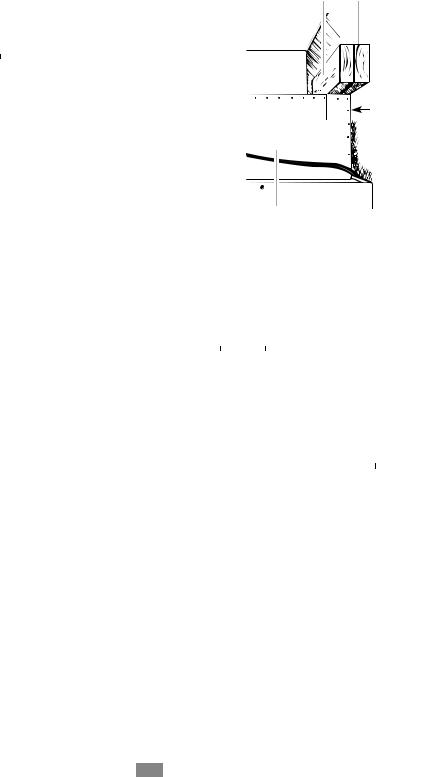
WATER SUPPLY REQUIREMENTS
IMPORTANT:
•If you turn the refrigerator on before the water line is connected, turn the ice maker off.
•All installations must meet local plumbing code requirements.
•Use copper tubing and check for leaks. Install copper tubing only in areas where temperatures will remain above freezing.
A kit is available with a 1/4 (6.35 mm) saddletype shutoff valve, a union, and copper tubing. Before purchasing the kit, make sure that a saddle-type valve complies with local plumbing codes. Do not use a piercing-type or a 3/16 (4.76 mm) saddle valve because they reduce water flow and clog easily.
Connect the ice maker to a cold water line with water pressure between 15 and 100 psi (103 - 690 kPa). If you have questions about water pressure, contact the water utility company.
ANTI-TIP BOARDS
IMPORTANT:
•The solid soffit must be within 1 ″ (2.5 cm) maximum above the refrigerator. If the solid soffit is higher than 1 ″ (2.5 cm), or one is not available, prevent the refrigerator from tipping during use, as shown.
•It is recommended that the boards be installed before the refrigerator is installed.
•Boards must be long enough to fully cover the width of the compressor cover.
• Locate the boards so the bottom surface of the boards are 84″ (213 cm) from the floor.
• During installation, raise the refrigerator up so there is 1/4″ (6.4 mm) maximum between the top of the refrigerator and the bottom of the anti-tip boards. Do not crush the condenser cover when raising the rear leveling
legs.
1 2




 3
3
2" (5 cm) 
4
1.Center board 1/4" (6 mm) max. above refrigerator
2.Two 2" x 4" x 32" (5 cm x 10 cm x 81 cm) boards
3.Attach to studs with 6-#8 x 3" (7.6 cm) screws
4.Compressor cover
To Install The Anti-Tip Boards:
1.Mark the stud locations on the rear wall 80 to 90 (203 - 229 cm) above the floor.
2. Securely attach one or two 2 x 4 x 32 (5 cm x 10 cm x 81 cm) wood boards to the wall studs behind the refrigerator. Use six #8 x 3″ (7.6 cm) or longer wood screws. The wood screws must be screwed into the studs at least 1-1/2 (3.8 cm). The boardsmustoverlapthecompressorcover.
www.Appliantology2-3 .org
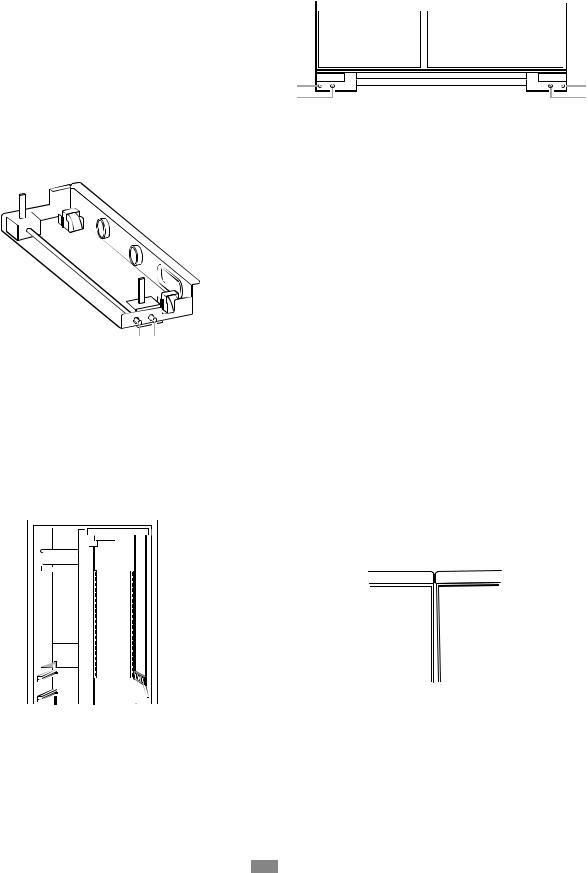
LOWERING THE LEVELING LEGS
All four leveling legs must contact the floor to support and stabilize the full weight of the refrigerator. Rollers are for moving the refrigerator, and not for permanent support.
Use a socket wrench to turn the leg levelers on both sides of the refrigerator to the right (clockwise) until the refrigerator weight is supported by the legs. The rollers should be off the floor. To avoid cabinet damage, do not apply more than 50 in/lbs (58 cm/kg) of torque to the leveling legs.
1. Rear leveling legs
2. Front leveling legs
1 2
LEVELING THE REFRIGERATOR
NOTE: Door panels must be installed before leveling.
1.Open the doors and place a level on top of the refrigerator frame. Check to see if the refrigerator is level from left to right.
1 

2 


 2
2
1.Level to check left to right leveling
2.Level to check front to back leveling
2.Use the leveling bolts to adjust the leveling legs until the refrigerator is level from left to right.
1 |
|
|
|
1 |
|
|
|||
|
|
|||
2 |
2 |
|||
1.Rear leveling bolt
2.Front leveling bolt
3.Place a level on the shelves and check to see if the refrigerator is level from front to back.
4.Use the leveling bolts to adjust the leveling legs until the refrigerator is level from front to back.
5.Make sure that all four leveling legs contact the floor and support the full weight of the refrigerator.
6.Make a final check to see that the refrigerator is level.
ADJUSTING THE DOORS
Door Alignment
Use the following steps to adjust the door alignment to the left, right, in, or out.
1.Inspect the spacing of the gap between the freezer and refrigerator doors. Make sure that the spacing between the doors is the same distance at the top and bottom.
 1
1
1.Uneven door gap
2.If the door gap is uneven, the side trim must be removed so that you can see the entire door gasket liner. Remove the six phillips screws holding the side trim.
www.Appliantology2-4 .org
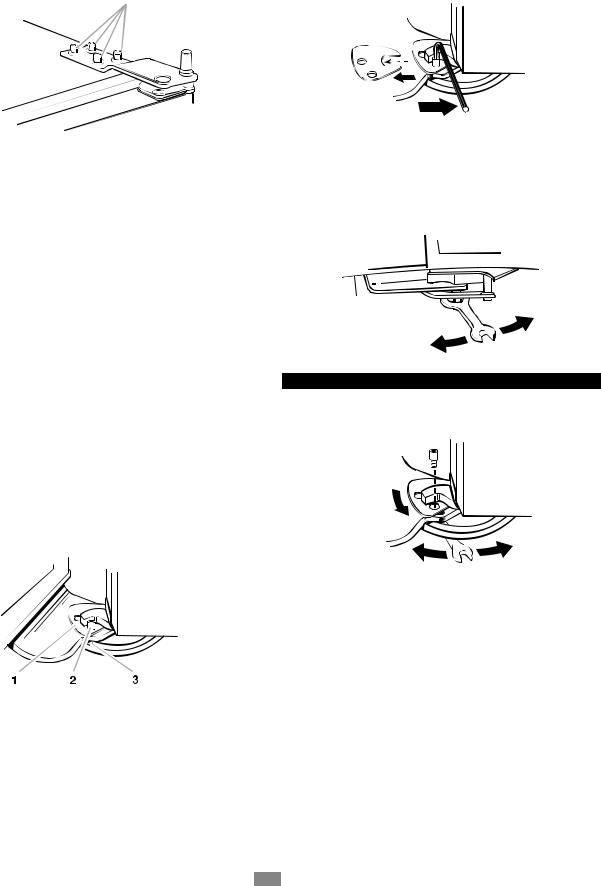
3.Loosen the four 3/8″ hex-head screws on top of both door hinges.
1
1.Mounting screws
4.Adjust the hinges so that the door gap is the same distance at the top and bottom.
5.Check the side door gasket gap. Make sure that the distance is the same at the top and bottom. Adjust the hinges, as necessary.
6.Recheck the front door gap spacing to make sure that it is properly aligned and even.
7.Tighten the top hinge screws securely.
8.Reinstall the side door trim.
Door Height Adjustment
Use the following steps to adjust the door height up or down after the doors have been leveled.
1.Open the freezer or refrigerator door and locate the hinge assembly at the bottom of the door.
2.Use an allen wrench and remove the door stop screw and locking plate from the bottom door hinge.
3.Use an open-end wrench and turn the bushing, located under the bottom of the hinge, to the left to raise the door, or to the right to lower the door.
screw. Turn the bushing slightly to align the hinge and locking plate screw holes.
1.Locking plate
2.Door stop screw
3.Bushing
www.Appliantology2-5 .org
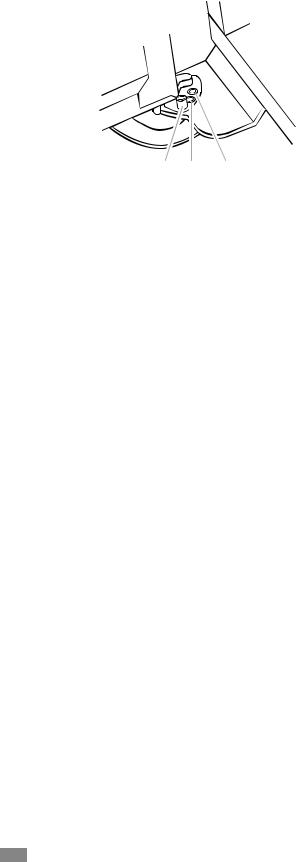
Door Swing Adjustment
1.Open the refrigerator and freezer doors and make sure that they open freely. If a door opens too wide, remove the door stop screw from the bottom hinge.
2.Move the door to the desired open position, and then reinstall the door stop screw at one of the three holes that is closest to the desired position.
1 2 3
1.Door stoop setscrew (130° position)
2.110 ° position.
3.90 ° position.
www.Appliantology2-6 .org
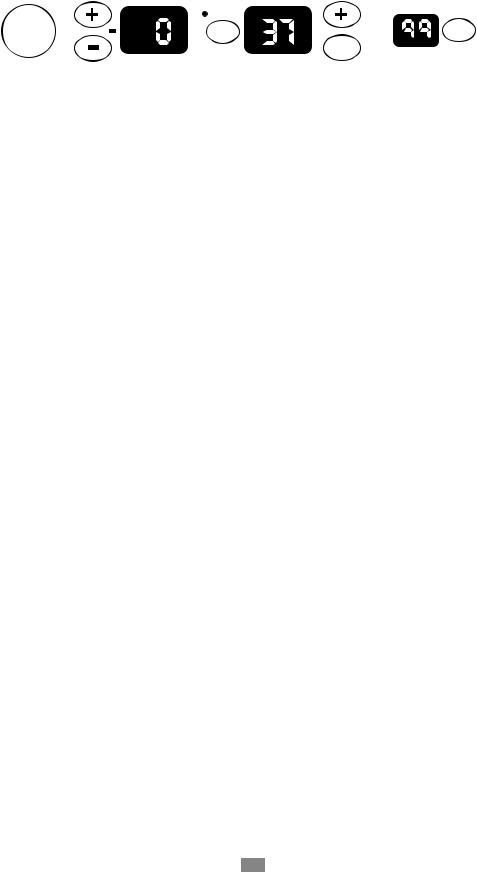
THEORY OF OPERATION
Warmer
Power
On/Off
Colder
FREEZER |
|
Warmer |
||
|
REFRIGERATOR |
|||
|
|
|
|
WATER FILTER |
|
°C |
|
|
RESET |
|
SELECT |
|
|
|
|
|
|
|
|
|
|
|
|
PERCENT LEFT |
|
|
|
|
|
Colder
THE ELECTRONIC TEMPERATURE CONTROL PANEL
OVERVIEW
The KitchenAid Built-In Refrigerator Constant Flow Temperature Management System uses twothermistorstomonitortemperaturechanges inside the refrigerator and freezer compartments. The electronic control manages the operation of the variable capacity compressor (VCC), a variable speed evaporator fan motor, and a variable position air door. The air door allows independent temperature control of the refrigerator and freezer compartments.
The electronic control seeks the most efficient means possible to maintain temperatures as it controls the operation and speed of the compressor and the evaporator fan motor. Higher fan speed is used before increasing the compressor speed to minimize power consumption. A nearly constant run time is sought at the lowest possible fan and compressor speed.
Freezer temperatures can be set from 9 F to –9 F (–13 C to –23 C). Refrigerator temperatures can be set from 46 F to 32 F, (8 C to 0 C).
The Adaptive Defrost Control (ADC) portion of the electronic control utilizes “pulsed defrost” technology to perform the defrost function (see page 3-4).
The electronic control monitors the water valve for total elapsed time and gallons of water used. The number displayed on the Water Filter Indicator (WFI) is the percentage of filter usage remaining.
The numeric display can be set for Fahrenheit or Celsius and displays the actual temperatures. The display range for the refrigerator is from 27 F to 70 F. The normal freezer display range is from –9 F to 70 F. Temperatures above or below these limits will be displayed at the corresponding temperature limit. During Max Cool, the freezer display will read –10 F, and the refrigerator will read 32 F.
The display will show the temperature setting any time the actual temperature is within ±6 F of the customer setting. This will prevent concern over temperature fluctuations when the doors are opened. Press the temperature adjustment key to view the current temperature setting, or to change the setting. When the temperature adjustment key is used to change the temperature setting, the display will brighten for 5 seconds.
Available features include:
•Water Filter Indicator
•Max Cool
•Over-Temperature Alarm
•Holiday Mode
www.Appliantology3-1 .org

TEMPERATURE CONTROL
The electronic control checks the resistance of the thermistors, and compares it to both the customer temperature settings and the last thermistor reading taken. This information is used to determine when to begin a cooling operation, and if a change is necessary in the damper setting, or the evaporator fan or compressor speed.
When a warm refrigerator is first put into a cooling mode, the air door partially opens, and the compressor and evaporator fan motors start to run at maximum rpm. The air door will gradually move to its fully open position.
As the actual temperature in the refrigerator nears the selected temperature setting, the electronic control compares the temperatures in both compartments. The compartment that has the greatest need for cooling, will control the speed of the evaporator fan motor.
Freezer Temperature Control —
Temperature Increasing
When the freezer calls for cooling, the compressor begins to run at minimum rpm, (see the chart on page 3-3), and the evaporator fan begins to run at 2000 rpm. The compressor and evaporator speeds are continuously updated. Speed changes are made based on:
•The difference between the actual temperature and the selected temperature settings.
•The rate of temperature change.
If the temperature increases 4 F above the selected temperature setting, the evaporator fan speed begins to gradually increase. The evaporator fan motor reaches the maximum speed of 3000 rpm at 5 F above the selected temperature setting, and the compressor speed begins to gradually increase. A maximum compressor speed of 4500 rpm will be reached at 9 F above the selected temperature setting.
Freezer Temperature Control —
Temperature Decreasing
When the freezer temperature begins to decrease, the process will reverse. The compressor speed decreases, followed by the evaporator fan speed.
Refrigerator Temperature Control —
Temperature Increasing
When the refrigerator calls for cooling while the freezer is satisfied, the air door begins to open, and the evaporator fan starts to run at minimum speed. If the temperature continues to rise, the air door will continue to open. If the temperature continues to rise after the air door is fully open, the evaporator fan speed will gradually increase to a maximum of 3000 rpm. If the temperature continues to rise, the compressor starts to run, or if it has already been running, begins to increase in speed.
Refrigerator Temperature Control —
Temperature Decreasing
As the refrigerator temperature approaches the selected setting, the control compares the temperatures in both compartments to determine which compartment will control the fan speed. If the freezer is further from the selected temperature setting, it controls the fan speed, and the air door begins to close, thus reducing the airflow to the refrigerator.
If the freezer is satisfied, the air door remains open, and the fan speed begins to decrease. When the selected temperature setting is reached, the air door closes.
www.Appliantology3-2 .org

COMPRESSOR
The main control board supplies a 5 vdc, peak- to-peak square wave, at 54 to 150 Hz, to the inverter board. A standard VOM will read approximately 2.5 vdc. The inverter board supplies the variable capacity compressor with three-phase 230 vac. Varying the frequency to the inverter board, and not the voltage, changes the speed of the compressor. The compressor can run at speeds of 1620 to 4500
rpm.
NOTE: It is not necessary, nor is it recommended, to test the output of the inverter board.
While the compressor is running, its speed is continuously updated. Speed is determined after analyzing two factors:
•The difference between the actual temperature and the selected temperature settings.
•The rate of temperature change.
Minimum compressor speed is based on the freezer’s selected temperature setting, as shown in the following chart.
Freezer Temperature |
|
Compressor |
|
|
Setting (°F) |
|
Minimum Speed |
|
|
|
|
|
|
|
9 to –2 |
|
1620 rpm |
|
|
|
|
|
|
|
–3 |
|
1800 rpm |
|
|
– 4 |
|
2000 |
rpm |
|
|
|
|
|
|
–5 |
|
2200 |
rpm |
|
–6 |
|
2400 rpm |
|
|
|
|
|
|
|
–7 |
|
2600 |
rpm |
|
–8 |
|
2800 |
rpm |
|
|
|
|
|
|
–9 |
|
3000 |
rpm |
|
–10 |
|
3200 |
rpm |
|
The compressor generally cycles on and off according to the cut-in and cut-out temperatures of the freezer, however, the refrigerator can turn on the compressor if the evaporator fan is at maximum speed and the refrigerator temperatures are not dropping.
COMPRESSOR PROTECTION
To protect the compressor and maintain efficiency, minimum compressor off time is programmed into the control. When the compressor turns off, a minimum of 7 minutes must elapse before allowing a restart.
The inverter board utilizes a current limiting device and thermal protection that eliminates the need for a compressor mounted thermal protector.
EVAPORATOR FAN MOTOR
The evaporator fan motor is a 12 vdc, variable speed motor. The motor has four wires:
•A blue wire provides feedback to monitor the speed of the motor.
•A red wire provides a constant 12 vdc.
•A yellow wire provides a variable voltage of between 5 vdc and 17 vdc to control the motor speed from 2000 to 3000 rpm.
•A white wire provides a common return.
EVAPORATOR FAN &
AIR DOOR DELAY
After defrost, an evaporator fan delay prevents unnecessary movement of warm, moist air through the refrigerator, by chilling the evaporator prior to starting the fan. Immediately after defrost drip time, the compressor starts at 4500 rpm, but the evaporator fan is delayed for 8 minutes. The air door remains closed for 8 minutes following defrost.
AIR DOOR
The air door is driven by a reversible DC stepper motor. The motor operates on a 12 vdc, peak-to-peak square wave. Voltage is delivered to the air door in a series of short pulses. It is not possible to obtain a reliable voltage reading with a VOM.
Separate windings are used to move the air door open or closed. The door can be in any one of 1800 positions from 0 to 90 degrees. The air door is used to fine-tune the airflow to the refrigerator.
www.Appliantology3-3 .org

The refrigerator temperature determines the opening of the air door. When the refrigerator requires cooling, if the evaporator fan motor is already running for the freezer, the air door partially opens, and then adjusts, if necessary. While the refrigerator is cooling, the door will be adjusting continuously to maintain or recover refrigerator temperature.
ADAPTIVE DEFROST
The adaptive defrost control allows the unit to enter a defrost mode only when it is needed. When powered up for the first time, the control initiates a defrost cycle after 8 hours of compressor run time. By monitoring the duration of defrost heating time and compressor run time, the control will continuously adapt the time between defrosts to optimize efficiency. Time between defrost periods will vary between 8 and 100+ hours.
Defrost will occur immediately when the compressor has run at 4000 rpm or greater for 1 hour, and 8 hours have elapsed since the last defrost.
PULSED DEFROST
For the first 2 minutes of defrost, the heater is on continuously. It will then cycle off for 1 minute, and back on for 2 minutes. The heater will continue to cycle at this ratio until the bimetal opens, or until 33 minutes has elapsed. At this point, heat is discontinued, and a 4-minute “drip time” begins. This allows the water to drain before the unit returns to a cooling mode. Maximum defrost time, (pulsed heat on/off time + drip time) is 37 minutes.
When entering a defrost cycle, if the bimetal is open, the time to defrost is reset to 8 hours, and the control will time through the entire 37 minute defrost period. During diagnostics this will allow a technician time to look for heater operation, and if necessary, bypass the bimetal.
POWER INTERRUPTION
After a power interruption, the following events will occur:
•The unit returns to the same operating mode and settings in use prior to the power interruption. If the unit was off, it remains off.
•Initially, the compressor, evaporator fan, and condenser fan motors will be off.
•The air door will close, and then adjust to the proper opening. The evaporator fan starts when the air door opens.
•The adaptive defrost control resets the compressor run time counter to 0, and if the freezer is above 20 F, the time to defrost is set to 8 hours.
•If the freezer temperature is below 12 F, the compressor starts after a delay of 7 minutes. If the freezer temperature is above 12 F, the compressor starts immediately.
FAILURE DEFAULTS
In the event of a thermistor, or keypad failure, the control uses one of the following default modes, which will continue until the failure is corrected.
Refrigerator Thermistor
If the control senses an open or a shorted thermistor, the air door and the evaporator fan motor will begin to operate on a timed on and off cycle, based on current selected temperature settings. The evaporator fan motor will run when the air door is open.
At mid-settings of 37 F / 0 F, the air door will open for 16 minutes, and close for 30 minutes. Setting the freezer colder, or the refrigerator warmer, will reduce the door-open time. Setting the freezer warmer, or the refrigerator colder, will increase the door-open time.
www.Appliantology3-4 .org

Freezer Thermistor
If the control senses an open or a shorted thermistor, the compressor and the evaporator fan motor will begin to operate on a timed on and off cycle. The cycle time is based on current selected temperature settings.
At mid-settings of 37 F / 0 C, the compressor and the evaporator fan motors will run for 35 minutes, and be off for 25 minutes. Setting the freezer colder will increase the run time. Setting the freezer warmer will decrease the run time.
The compressor will run at minimum speed. The evaporator fan will also run at minimum speed, unless the refrigerator compartment requests a higher speed.
Keypad
If the control detects that the keypad is not working, it reverts to the default temperature settings of 37 F in the refrigerator, and 0 F in the freezer.
Evaporator Fan Motor
If the evaporator fan motor malfunctions, the compressor will run at 4500 rpm for an indefinite period, except during the defrost periods. The “Call Service Alarm” will sound until the failure has been corrected.
ELECTRONIC CONTROL
THERMAL SHUTOFF
The electronic control utilizes an on-board thermistor to shut the compressor off if the temperature rises above 160 F (71 C). When the temperature drops to 130 F (55 C), the compressor returns to normal operation. This cycle continues indefinitely until the cause of the high temperature has been corrected.
If this cycle is repeated four times within 24 hours, the “Call Service” indicator lights, and the alarm sounds.
MAX COOL MODE
Max Cool changes the refrigerator temperature setting to 32 F (0 C) and the freezer to –10 F (–23 C) for 24 hours. During Max Cool, the freezer and refrigerator temperature displays show the new temperature settings, not the actual temperatures.
In most cases the motors run 100% for more than 1 hour. The control returns to the previous user setting after 24 hours, or any time the temperature settings are changed.
AUTOMATIC MAX ICE
Automatic Max Ice operates any time the ice maker water valve is energized. The duration of Automatic Max Ice is 1-1/2 hours. During Automatic Max Ice the following occurs:
•The freezer display shows the user temperature settings and not the actual temperature.
•The freezer temperature setting changes to
–9 F (–23 C).
•The evaporator fan runs at 3000 rpm.
•The compressor runs the entire 1-1/2 hour mode. Speed is determined by the difference between actual freezer temperature and -9 F (-23 C).
HOLIDAY MODE
The Holiday Mode may be used for the following occasions:
•On vacation.
•Religious observance (Sabbath Mode).
When the Holiday Mode is selected, the corresponding green LED flashes for 2 seconds, and then remains on, to indicate that the feature is activated.
www.Appliantology3-5 .org
